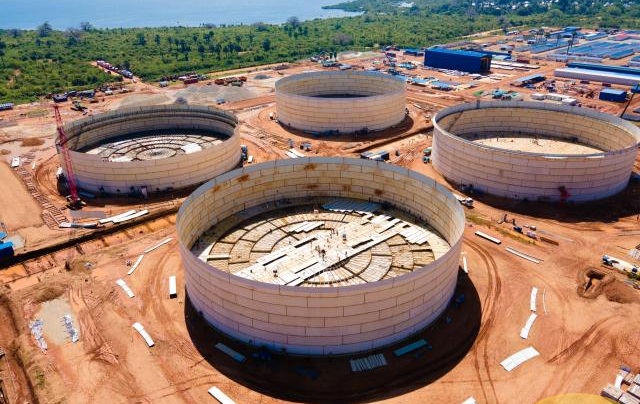
Tanga, Tanzania | THE INDEPENDENT | Officials based at Uganda’s High Commission in Tanzania toured oil export terminals being constructed in Tanga as part of the East Africa Crude Oil Pipeline.
Led by Ambassador (Rtd.) Col. Fred Mwesigye, the delegation that included teams from the Petroleum Authority of Uganda (PAU said it was impressed by the progress.
“This project exemplifies the collaboration between Tanzania and Uganda, as well as the commitment of all stakeholders. It is remarkable to witness the substantial progress being made in establishing a world-class facility that benefits both nations,” said Mwesigye.
The offshore facility consisting of a 2.1-kilometer trestle extending into the Indian Ocean and a load out facility, is being constructed by a joint venture of Ballast-Nedam and Besix (BBN).
A statement from the Petroleum Authority said the facility was at 60% completion. The terminal hosts pipelines loading facility, telecommunication systems, firefighting equipment, and six dolphins to support crude oil loading operations. Completion is anticipated by October 2025.
Musa Msafiri, the EACOP Engineer at the terminal said construction is progressing smoothly, with the storage tanks now 69.8% complete.
“Our goal is to complete the project as scheduled. While some areas of construction are in advanced stages, work is still ongoing in others,” he said.
Another crucial component of the EACOP project is the Marine Storage Terminal (MST) in Chongoleani, Tanga. The Marine Storage Terminal features four massive crude oil storage tanks, each with a capacity of 500,000 barrels.
Construction of the tanks was progressing , with three fully welded to their final height and the fourth nearing completion. Once finished, the tanks will undergo hydro testing and non-destructive testing beginning in January 2025.
The Marine Storage Terminal also boasts of a 600-person camp to support construction activities, with 1,259 workers currently on site—1,155 of whom are Tanzanian nationals. This local involvement highlights the project’s commitment to capacity building and regional workforce development.
The EACOP Project areas are bustling with activity, including the fabrication of components, installation of pipelines, and foundation work for various systems.
The facility’s comprehensive design integrates bulk heaters, pumps, metering systems, and utility platforms to ensure seamless operations once the pipeline becomes operational.
Eng. Deo Bukenya, a Senior Pipeline Engineer with the PAU, expressed satisfaction with the project’s progress and its potential to achieve its goals.
“The progress made by EACOP Ltd in implementing the project is commendable. They have also taken all necessary measures to ensure environmental protection, the safety of personnel, and minimal impact on local communities. It’s remarkable to see so many nationals involved in the project,” he said.
He added, “On Uganda’s side, the project is also progressing well, with significant infrastructure development underway, much like here in Tanzania.”
The project has already received over 800 kilometres of line pipes at the Nzega Coating Yard Plant in Tanzania, and pipeline welding activities are ongoing in both Uganda and Tanzania.
In September, the Ugandan section marked a milestone with the first delivery of nine truckloads of coated line pipes to the Main Camp and Pipe Yard (MCPY) 4 in Kyotera District.
An essential infrastructure component for the project in Tanzania is a pipeline coating plant located in Sojo, Nzega District, in Tabora Region. The EACOP will transport crude oil from Uganda’s Hoima district to the Tanga Port – Tanzania for export.
Approximately 80% of the pipeline lies within Tanzanian territory, spanning eight regions. The buried, thermally insulated pipeline is designed to minimize its environmental footprint while providing economic opportunities for local communities.
*****
URN
 The Independent Uganda: You get the Truth we Pay the Price
The Independent Uganda: You get the Truth we Pay the Price


